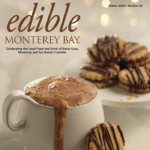False Food
Artists Jerry and Pamela Takigawa make art with a cause out of deadly, beautiful trash
By Lisa Crawford Watson
 Soaring above the Pacific Ocean, the albatross is scanning below for her next opportunity to feed. She looks for squid, fish or krill. When she sees something alluring, she dives and breaks the ocean’s surface, only to ingest a meal of discarded plastic. These bits of waste that collect in the Pacific become “false food” to birds and other creatures of the sea. And like junk food that leaves little room in people’s stomachs for more nutritious food, ultimately causing life-threatening diseases like obesity and type 2 diabetes, the plastic can have deadly consequences for the animals, leaving no space in their stomachs for food of any kind.
Soaring above the Pacific Ocean, the albatross is scanning below for her next opportunity to feed. She looks for squid, fish or krill. When she sees something alluring, she dives and breaks the ocean’s surface, only to ingest a meal of discarded plastic. These bits of waste that collect in the Pacific become “false food” to birds and other creatures of the sea. And like junk food that leaves little room in people’s stomachs for more nutritious food, ultimately causing life-threatening diseases like obesity and type 2 diabetes, the plastic can have deadly consequences for the animals, leaving no space in their stomachs for food of any kind.
In a stunning and gently provocative show that will run at the Chesebro Tasting Room in Carmel from Sept. 28 through Nov. 3, Jerry and Pamela Takigawa invite the viewer to reflect on the tragic impact of our wasteful ways on the sea creatures with which we share our planet. The show, Expanding Horizons, will begin with an opening reception on Sept. 28.
Jerry Takigawa, a fine art photographer and designer whose firm Takigawa Design is located on Cannery Row, became inspired to make the series he’ll display when he saw an installation of colorful plastic trash gathered by the nearby Monterey Bay Aquarium. All of the refuse was collected from the bellies of dead albatrosses. Takigawa has photographed assemblages of this very same material, turning the killer garbage into beautiful, consciousness-raising art.
“Aesthetics keep the story alive. One can only look so long at documentary images of dead birds with plastic,” Jerry says. “There
is irony in creating art out of garbage, yet through its beauty or aesthetic we can at least stay with it long enough to get the story and appreciate the subtext. You have to find a way to inspire people in order to motivate them to do something. That’s where art comes in.”
Takigawa’s intent to promote action through beauty is complemented by the luminous representational oil-on-paper and acrylic-on-panel paintings of birds that Pamela will contribute to the show.
Ultimately, the Takigawas want us to appreciate the way in which all things in the environment are connected—that “what we do to the environment, we do to us,” Jerry writes in a program for an earlier show at the Cherry Center for the Arts in Carmel.
Plastic degrades extremely slowing, gradually breaking down into a “soup of molecular plastic” in the sea, which is then ingested by the fish we eat ourselves.
“At this size,” Takigawa writes, “plastic enters the food chain and ‘we’ become the albatross.”
Lisa Crawford Watson lives with her family on the Monterey Peninsula, where she is a freelance writer and an instructor of writing and journalism at California State University Monterey Bay and Monterey Peninsula College.
Chesebro Tasting Room • 19 E. Carmel Valley Road, Carmel Valley • 831.659.5098 • www.chesebrowines.com
About the author
At Edible Monterey Bay, our mission is to celebrate the local food culture of Santa Cruz, San Benito and Monterey Counties, season by season. We believe in sustainability, and we believe everyone has a right to healthful, clean and affordable food. We think knowing where our food comes from is powerful, and we hope our magazine, website and newsletters inspire readers to get to know and support our local growers, fishers, chefs, vintners and food artisans.
- Edible Monterey Bayhttps://www.ediblemontereybay.com/author/ediblemontereybay/
- Edible Monterey Bayhttps://www.ediblemontereybay.com/author/ediblemontereybay/
- Edible Monterey Bayhttps://www.ediblemontereybay.com/author/ediblemontereybay/
- Edible Monterey Bayhttps://www.ediblemontereybay.com/author/ediblemontereybay/




